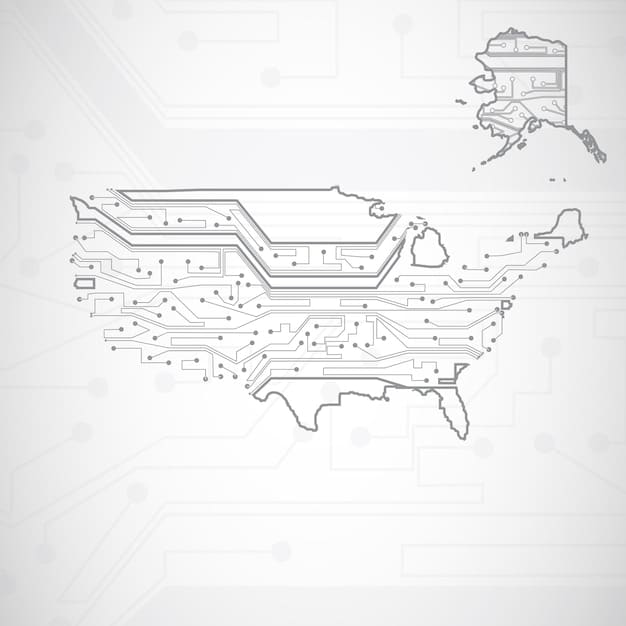Gerrymandering’s Impact: Can Independent Commissions Ensure Fair Representation?

Gerrymandering, the manipulation of electoral district boundaries for political advantage, significantly impacts fair representation in the US, raising the question of whether independent redistricting commissions can level the playing field and ensure more equitable outcomes.
The practice of gerrymandering, where electoral district boundaries are manipulated to favor one political party or group, has long been a contentious issue in the United States. This manipulation undermines the principle of fair representation, leading many to question whether independent redistricting commissions can truly level the playing field.
Understanding Gerrymandering and Its Effects
The term “gerrymandering” comes from Elbridge Gerry, the governor of Massachusetts in 1812, who approved a redistricting plan that created a district shaped like a salamander to benefit his party. Today, the practice continues to be used across the US, often resulting in oddly shaped districts designed to maximize one party’s chances of winning elections. This section delves into the history, methods, and consequences of gerrymandering on the American political landscape.
Historical Context of Gerrymandering
The roots of gerrymandering can be traced back to the early 19th century. While Elbridge Gerry’s actions gave the practice its name, the concept of manipulating district lines for political gain has been around since the early days of American democracy. Understanding this history provides insight into how deeply ingrained gerrymandering is in the US political system.
Methods Used in Gerrymandering
Gerrymandering involves several techniques to achieve the desired partisan outcome:
* **Cracking:** Dividing a political group’s supporters among multiple districts to dilute their voting power.
* **Packing:** Concentrating the opposing party’s voters into a single district to reduce their influence in other districts.
* **Stacking:** Combining disparate demographics into a single district to give a particular group an advantage.
These methods allow political parties to create “safe” districts where their candidates are virtually guaranteed to win, reducing competitiveness and voter engagement.

The effects of gerrymandering are numerous and far-reaching. Reduced competition depresses voter turnout, increases polarization, and makes elected officials less accountable to their constituents. It can also result in a system where politicians choose their voters, rather than the other way around. This creates an environment where the voices of certain communities are marginalized, and the outcome of elections is predetermined. Gerrymandering undermines the basic principles of democracy. The manipulation of district boundaries undermines the representational intent of elections, leading to skewed results that don’t reflect voters’ preferences.
Independent Redistricting Commissions: A Potential Solution?
Many advocates for electoral reform believe that independent redistricting commissions offer a promising solution to address the negative impacts of gerrymandering. These commissions are tasked with creating district maps that are fair, competitive, and representative of the population. This section examines the structure, function, and effectiveness of these commissions in promoting fair representation.
The Structure of Independent Redistricting Commissions
Independent redistricting commissions typically consist of members who are not elected officials or active members of political parties. The selection process often involves a combination of appointments by state leaders and independent committees to ensure a diverse and nonpartisan membership.
How Independent Commissions Function
These commissions operate under specific guidelines aimed at ensuring fairness and transparency. These guidelines often include:
* Adhering to established criteria such as compactness, contiguity, and respect for existing political subdivisions and communities of interest.
* Conducting public hearings to gather input from citizens and stakeholders.
* Making decisions in a transparent manner, with opportunities for public review and comment on proposed maps.
* Preventing consideration of political data, such as past election results or voter registration information.
Evaluating the Effectiveness of Independent Commissions
The effectiveness of independent redistricting commissions can be evaluated based on several factors:
* **Competitiveness:** Do the maps they create result in more competitive elections?
* **Fairness:** Do the maps accurately reflect the partisan preferences of the state’s voters?
* **Representation:** Do all communities have a fair opportunity to elect representatives of their choice?
Studies show that independent commissions are better at reducing partisan bias in district maps. When compared to traditional districting methods, independent commissions were found to produce more competitive districts.
Independent redistricting commissions appear to be more capable of reducing partisan gerrymandering, promoting competitive elections, and ensuring better representation. They address the harmful effects of partisan gerrymandering by creating maps that are more favorable to the population than to political parties.
Case Studies: States with and without Independent Commissions
To better understand the impact of independent redistricting commissions, it is helpful to examine specific examples of states that have adopted them and those that have not. Comparing and contrasting their experiences can provide valuable insights into the potential benefits and challenges of this reform.
California: A State with an Independent Commission
California established an independent redistricting commission in 2008 to redraw the state’s congressional and legislative districts. The commission consists of five Democrats, five Republicans, and four members who are either independent or belong to a minor party. It is subject to strict criteria and must adhere to transparency requirements.
Texas: A State without an Independent Commission
Texas relies on its state legislature to redraw district lines. In 2011, the state’s Republican-controlled legislature approved a new set of congressional and legislative districts that were quickly challenged in court. Opponents argued that the maps discriminated against minority voters and favored Republican candidates. This example highlights the partisan nature of redistricting when left to the legislature.
Comparing Outcomes: Representation and Competition
The differences in representation and competition between California and Texas are stark. California’s independent commission has led to more competitive elections and better representation of the state’s diverse population. In contrast, Texas’s politically driven redistricting process has resulted in entrenched partisan advantages and reduced competitiveness. In sum, independent commissions are more impartial when it comes to creating impartial districts and providing fair representation.
Challenges and Limitations of Independent Commissions
While independent redistricting commissions offer a promising avenue for reform, they are not without their challenges and limitations. Understanding these potential drawbacks is essential for evaluating their overall effectiveness.
Potential for Gridlock and Inefficiency
Independent commissions can face challenges related to reaching consensus and making timely decisions. The diverse viewpoints and interests represented on these commissions can sometimes lead to gridlock or delays, especially when dealing with complex or controversial issues.
Influence of Special Interests and Lobbying
Even independent commissions can be subject to the influence of special interests and lobbying efforts. Interest groups may attempt to sway commission members or provide biased information to shape the outcome of the redistricting process.
Legal Challenges and Court Intervention
The maps created by independent commissions can be challenged in court, particularly if they are alleged to violate constitutional or statutory requirements. Legal battles can be costly and time-consuming, and they can ultimately undermine the commission’s authority. It is important commissions meet standards, but this can be challenging.

Independent redistricting commissions are not immune to challenges and limitations. While they represent an improvement, legal challenges, and possible influence of special interests can still result in maps that are unbalanced. It is crucial to be aware of these obstacles and take steps to address them in order to reap the rewards of independent commissions.
The Future of Redistricting Reform
The push for redistricting reform is ongoing across the United States. There are several potential avenues for further progress, including legislative action, ballot initiatives, and judicial rulings.
Legislative Efforts to Promote Independent Commissions
Many states are considering or have already introduced legislation to establish independent redistricting commissions. These efforts often face significant opposition from political parties and incumbents who are reluctant to give up control over the redistricting process. The future is uncertain, and changes are still in progress.
Ballot Initiatives and Citizen-Led Reform
In some states, citizens have taken matters into their own hands by launching ballot initiatives to create independent redistricting commissions. These initiatives allow voters to directly decide whether to adopt this reform.
Judicial Rulings on Gerrymandering and Redistricting
The courts have played a significant role in shaping the legal landscape of redistricting, particularly through challenges to partisan and racial gerrymandering. These rulings can provide important guideposts for states seeking to reform their redistricting processes. All three facets will have a vital role in coming years as things continue to evolve.
| Key Point | Brief Description |
|---|---|
| 🗺️ Gerrymandering | Manipulation of district boundaries for political advantage. |
| ⚖️ Independent Commissions | Aim to create fair, competitive, and representative districts. |
| 🗳️ Legislative Efforts | States considering or passing laws for independent commissions. |
| 👨⚖️ Judicial Rulings | Courts help define redistricting laws and challenges. |
Frequently Asked Questions
▼
Gerrymandering is the practice of drawing electoral district boundaries to favor one political party or group over another. It involves techniques like cracking (diluting voter power) and packing (concentrating voters to reduce their influence).
▼
These commissions are bodies tasked with creating district maps that are fair, competitive, and representative. They typically consist of members who are not elected officials and are not heavily involved with political parties.
▼
Studies suggest that independent commissions are more effective at reducing partisan bias in district maps. These commissions have been shown to create more competitive districts compared to those in legislature-controlled states.
▼
Commissions may experience gridlock due to diverse viewpoints, influence from special interests, and legal challenges. Strict criteria and transparency requirements can also create potential challenges for the commissions.
▼
The future of redistricting involves continuous efforts to establish independent commissions through legislation, ballot initiatives, and judicial rulings. These can greatly shape the legal landscape.
Conclusion
Eradicating gerrymandering and promoting fair representation requires a multifaceted approach. While independent redistricting commissions possess the potential to be a valuable instrument in attaining these goals, they should not be viewed as a comprehensive solution. Challenges exist; they must be carefully managed. They represent a crucial stride towards a more equitable and representative democracy in the United States.





